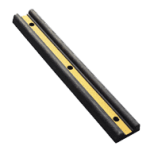Definition of speed bumps
Speed bumps, also known as speed humps or speed breakers, are traffic calming devices designed to slow down vehicles and improve safety in areas with high pedestrian activity or where speed limits need to be enforced. These raised structures are typically made from various materials such as concrete, asphalt, rubber, or plastic. The selection of materials depends on factors such as the desired level of durability, cost, and environmental impact. Each material has its own set of advantages and disadvantages, and the choice of material can vary depending on the specific requirements of the road or parking lot where the speed bumps are being installed.
Importance of speed bumps
Speed bumps play a crucial role in ensuring road safety and traffic calming. They are strategically placed on roads to reduce vehicle speed and encourage drivers to be more cautious. The importance of speed bumps cannot be overstated as they effectively slow down traffic in areas where speed control is necessary, such as school zones, residential areas, and parking lots. By forcing drivers to slow down, speed bumps help prevent accidents, protect pedestrians, and minimize the risk of property damage. Additionally, speed bumps also serve as a visual reminder for drivers to be mindful of their surroundings and adhere to the designated speed limits. Overall, the presence of speed bumps greatly contributes to creating a safer and more controlled driving environment.
Purpose of the article
The purpose of this article is to provide an overview of the common materials used in speed bump construction. Speed bumps are widely used in various settings, such as residential areas, parking lots, and school zones, to control vehicle speed and improve safety. By understanding the different materials used in speed bump construction, readers will gain insights into the factors that contribute to their effectiveness and durability. This article aims to educate readers on the advantages and disadvantages of each material, helping them make informed decisions when it comes to speed bump installation and maintenance.
Asphalt
Properties of asphalt
Asphalt is a commonly used material in speed bump construction due to its favorable properties. It is known for its durability and ability to withstand heavy traffic loads. Asphalt is also resistant to weather elements such as rain, snow, and heat, making it suitable for various climates. Additionally, it provides a smooth and comfortable driving experience for motorists while effectively reducing vehicle speed. The versatility of asphalt allows for easy installation and maintenance, making it a cost-effective choice for speed bump construction projects.
Advantages of using asphalt in speed bump construction
Asphalt is a commonly used material in speed bump construction due to its numerous advantages. One of the main benefits of using asphalt is its durability. Asphalt is known for its ability to withstand heavy traffic and harsh weather conditions, making it ideal for speed bumps that need to endure constant use and exposure to the elements. Additionally, asphalt is a flexible material, which allows it to adapt to changes in temperature and prevent cracking or damage. This flexibility also provides a smoother and more comfortable ride for vehicles passing over the speed bumps. Another advantage of using asphalt is its cost-effectiveness. Compared to other materials, such as concrete or rubber, asphalt is generally more affordable, making it a popular choice for speed bump construction. Overall, the use of asphalt in speed bump construction offers durability, flexibility, and cost-effectiveness, making it a reliable option for ensuring road safety and traffic control.
Disadvantages of using asphalt in speed bump construction
One of the main disadvantages of using asphalt in speed bump construction is its susceptibility to damage. Asphalt is prone to cracking and crumbling over time, especially when exposed to heavy traffic and extreme weather conditions. This can lead to the need for frequent repairs and maintenance, which can be time-consuming and costly. Additionally, asphalt speed bumps may not provide the same level of durability and longevity as speed bumps made from other materials, such as rubber or concrete. Therefore, it is important to consider these drawbacks when deciding on the material for speed bump construction.
Concrete
Properties of concrete
Concrete is a widely used material in the construction industry, and it also finds its application in the construction of speed bumps. The properties of concrete make it an ideal choice for speed bump construction. Concrete is known for its strength and durability, which allows speed bumps to withstand heavy traffic and constant use. Additionally, concrete has a high load-bearing capacity, ensuring that it can support the weight of vehicles without any deformation. Moreover, concrete can be easily molded into various shapes and sizes, making it versatile for creating speed bumps that meet specific design requirements. Overall, the properties of concrete make it a reliable and long-lasting material for constructing speed bumps.
Advantages of using concrete in speed bump construction
Concrete is a widely used material in speed bump construction due to its numerous advantages. One of the main advantages of using concrete is its durability. Concrete speed bumps are able to withstand heavy traffic and extreme weather conditions, making them a long-lasting solution. Additionally, concrete speed bumps provide excellent visibility, as they can be painted with bright colors or have reflective strips embedded in them. This ensures that drivers are aware of their presence and helps to prevent accidents. Furthermore, concrete speed bumps are easy to install and maintain, making them a cost-effective choice for road authorities. Overall, the use of concrete in speed bump construction offers durability, visibility, and cost-effectiveness, making it a preferred material for creating safe road environments.
Disadvantages of using concrete in speed bump construction
Concrete is a commonly used material in speed bump construction due to its durability and strength. However, it also has its disadvantages. One major drawback of using concrete in speed bump construction is its rigid nature. Concrete speed bumps can be quite harsh and uncomfortable for vehicles to drive over, especially at higher speeds. This can lead to a bumpy and uncomfortable ride for drivers, potentially causing damage to vehicles and discomfort to passengers. Additionally, concrete speed bumps can be difficult to install and require specialized equipment and expertise. They are also more expensive compared to other materials used in speed bump construction. Overall, while concrete is a popular choice for speed bump construction, its disadvantages should be carefully considered before deciding on its use.
Rubber
Properties of rubber
Rubber speed bumps are commonly used in road construction due to their unique properties. One of the key properties of rubber is its high elasticity, which allows it to effectively absorb and distribute the impact of vehicles passing over it. This not only helps to reduce the noise and vibration generated by vehicles, but also minimizes the potential damage to the vehicles themselves. Additionally, rubber speed bumps are highly durable and weather-resistant, making them suitable for use in various environmental conditions. Their non-slip surface provides enhanced traction, ensuring the safety of both drivers and pedestrians. Overall, the properties of rubber make it an ideal material for constructing speed bumps that effectively control vehicle speed and enhance road safety.
Advantages of using rubber in speed bump construction
Rubber is a popular material used in speed bumps and humps construction due to its numerous advantages. One of the main advantages is its ability to effectively reduce vehicle speed. Rubber speed bumps are designed to slow down vehicles by creating a noticeable and jarring impact when driven over. This not only helps in controlling and regulating traffic speed but also improves overall road safety. Additionally, rubber speed bumps are highly durable and resistant to wear and tear, making them suitable for long-term use. They are also weather-resistant, allowing them to withstand harsh environmental conditions without deteriorating. Another advantage of using rubber in speed bump construction is its versatility. Rubber can be easily molded and shaped into various sizes and designs, providing flexibility in installation. Moreover, rubber speed bumps are cost-effective compared to other materials, making them a preferred choice for many road authorities. Overall, the use of rubber in speed bump construction offers several advantages including effective speed reduction, durability, weather resistance, versatility, and cost-effectiveness.
Disadvantages of using rubber in speed bump construction
Rubber is a commonly used material in speed bump construction due to its durability and flexibility. However, there are several disadvantages associated with using rubber in this application. One major drawback is its susceptibility to extreme temperatures. Rubber speed bumps can become brittle and crack in cold weather, while they can soften and deform in hot weather. Additionally, rubber speed bumps may deteriorate over time due to exposure to UV rays, leading to a reduced lifespan. Another disadvantage is the potential for noise pollution. Rubber speed bumps can create loud and disruptive noise when vehicles pass over them, which can be a nuisance for nearby residents. Finally, rubber speed bumps may not be as effective in slowing down vehicles compared to other materials, as they can provide a smoother ride and less jolting sensation. Despite its popularity, it is important to consider these disadvantages when choosing the material for speed bump construction.
Plastic
Properties of plastic
Plastic is a widely used material in speed bump construction due to its unique properties. One of the key advantages of plastic is its durability, as it can withstand heavy traffic and harsh weather conditions without deteriorating. Additionally, plastic speed bumps are lightweight and easy to install, making them a popular choice for temporary or portable applications. Moreover, plastic is resistant to chemicals and UV radiation, ensuring that the speed bumps maintain their functionality and appearance over time. Overall, the properties of plastic make it an excellent choice for speed bump construction, providing a reliable and long-lasting solution for traffic calming measures.
Advantages of using plastic in speed bump construction
Plastic has become a popular choice in speed bump construction due to its numerous advantages. One of the main benefits of using plastic is its durability. Plastic speed bumps are designed to withstand heavy traffic and extreme weather conditions, making them a long-lasting option. Additionally, plastic speed bumps are lightweight and easy to install, reducing the time and effort required for construction. Another advantage of using plastic is its flexibility. Plastic speed bumps can be molded into various shapes and sizes, allowing for customization based on specific requirements. Furthermore, plastic is a cost-effective material compared to other alternatives, making it a preferred choice for many municipalities and organizations. Overall, the advantages of using plastic in speed bump construction make it an excellent option for enhancing road safety and traffic management.
Disadvantages of using plastic in speed bump construction
Plastic, although commonly used in speed bump construction, comes with several disadvantages. One major drawback is its susceptibility to damage from extreme temperatures. In hot weather, plastic speed bumps can soften and deform, losing their effectiveness and durability. Additionally, plastic speed bumps may become brittle in cold weather, making them prone to cracking and breaking. Another disadvantage of plastic speed bumps is their limited load-bearing capacity. Compared to other materials like rubber or concrete, plastic speed bumps may not be able to withstand heavy traffic or vehicles with high axle loads. Lastly, plastic speed bumps may require more frequent maintenance and replacement due to wear and tear, further increasing the overall cost of installation and upkeep. Considering these disadvantages, it is important to carefully evaluate the suitability of plastic speed bumps for specific road conditions and traffic requirements.
Metal
Properties of metal
Metal is a versatile material that is commonly used in the construction of speed bumps. It offers various properties that make it suitable for this purpose. One of the key properties of metal is its strength and durability. It can withstand heavy loads and constant traffic, making it ideal for withstanding the weight of vehicles passing over the speed bump. Additionally, metal is resistant to weathering and corrosion, ensuring that the speed bump remains in good condition even in harsh environmental conditions. Another advantage of using metal is its flexibility. It can be easily molded and shaped to create speed bumps of different sizes and designs. This allows for customization based on the specific requirements of the road or parking lot. Overall, the properties of metal make it a reliable and long-lasting choice for speed bump construction.
Advantages of using metal in speed bump construction
Metal is a widely used material in speed bump construction due to its numerous advantages. One of the key benefits of using metal in speed bump construction is its durability. Metal speed bumps are built to withstand heavy traffic, harsh weather conditions, and constant exposure to vehicles. They are less likely to crack, break, or deteriorate over time, ensuring a long-lasting solution. Additionally, metal speed bumps provide enhanced visibility due to their reflective properties, making them more noticeable to drivers, especially during low-light conditions. This helps in improving safety on the road, reducing the risk of accidents. Moreover, metal speed bumps can be easily customized to suit specific requirements, such as size, shape, and design. This flexibility allows for greater adaptability in different road settings and ensures that the speed bumps are effective in controlling speed and ensuring traffic compliance. Overall, the use of metal in speed bump construction offers significant advantages in terms of durability, visibility, and customization, making it a preferred choice for many road authorities and property owners.
Disadvantages of using metal in speed bump construction
Metal speed bumps have several disadvantages in their construction. Firstly, metal speed bumps tend to be more expensive compared to other materials. This can be a major drawback for organizations or municipalities with limited budgets. Additionally, metal speed bumps can be prone to rust and corrosion over time, especially in areas with harsh weather conditions. This can lead to a decrease in their effectiveness and durability. Furthermore, metal speed bumps can be noisy when vehicles drive over them, causing disturbance to nearby residents. Lastly, metal speed bumps may cause damage to vehicles if not properly installed or maintained, as the rigid nature of metal can result in jarring impacts. Considering these disadvantages, it is important to carefully evaluate the use of metal in speed bump construction and explore alternative materials that may be more cost-effective and durable.
What Is Durability?
Durability is the ability of a material to resist deterioration or damage caused by normal wear and tear, environmental exposure, and other external forces. It is the quality of being able to withstand extreme conditions over a long period of time. Durability is an important factor to consider when selecting materials for a product or construction project.
Types of Durable Materials
There are a variety of materials that are known for their durability. These include:
- Steel: Steel is an alloy of iron and carbon that is highly durable and resistant to corrosion.
- Concrete: Concrete is a mixture of cement, sand, and gravel that is used in the construction of buildings, bridges, and other structures.
- Wood: Wood is a natural material that is strong and resistant to wear and tear.
- Plastic: Plastic is a synthetic material that is lightweight, durable, and resistant to corrosion.
- Glass: Glass is a transparent material that is highly resistant to breakage.
Benefits of Durability
There are several benefits to using durable materials. These include:
- Longevity: Durable materials are designed to last for a long time and can withstand the wear and tear of everyday use.
- Cost Savings: Durable materials can save money in the long run by reducing the need for repairs and replacements.
- Safety: Durable materials are designed to be safe and reliable, and can help reduce the risk of injury or damage.
Conclusion
Durable materials are an important factor to consider when selecting materials for a product or construction project. They can provide longevity, cost savings, and safety benefits. If you are looking for a durable material for your project, consider Unimat Speed Bumps Unimat Speed Bumps.








